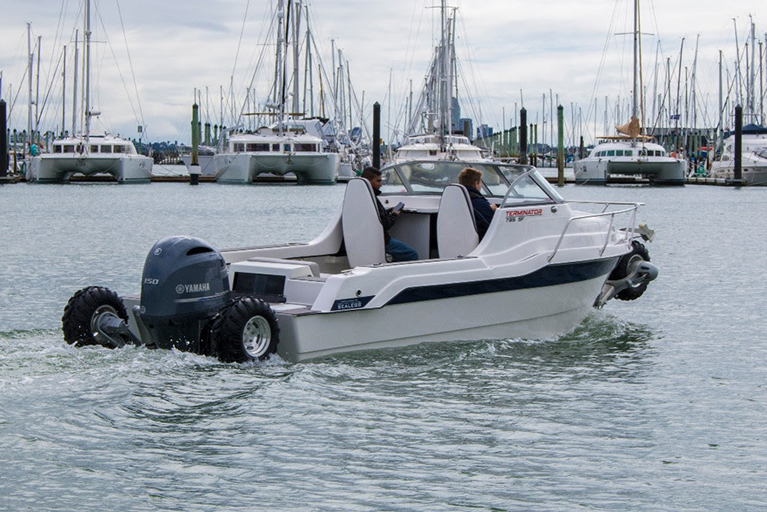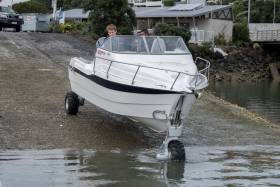Displaying items by tag: Amphibious
Terminator 755 Amphibious Boat By Sealegs On Show in Auckland
New Zealand based Sealegs International has announce the coming release of the Terminator 755 Amphibious by Sealegs at the Auckland On Water Boat Show. The craft features System 60, the amphibious enablement system (AES) by Sealegs, and was developed by Terminator Boats.
This latest addition to the expanding amphibious product range demonstrates the on-going efforts and success of the Sealegs AES Strategy previously seen in craft released by Stabicraft and ASIS. Sealegs plans to continue the strategy of developing amphibious craft through offering amphibious systems to global boat manufacturers to widen our product range and reach of customers.
Brazen Composites and its subsidiary Terminator Boats have a long history in building composite craft. The Terminator 755 is the first 100% fiberglass model released with Sealegs that does not feature the Hypalon or Aluminium pontoons previously seen in the rest of the Sealegs range.
 The standard hull and Amphibious Enablement System will have a retail starting price of just $149,000 + outboard, options
The standard hull and Amphibious Enablement System will have a retail starting price of just $149,000 + outboard, options
Sealegs CEO, David McKee Wright said “with every new partner we appoint under the AES strategy, our systems and processes improve to better accommodate the needs of a wider range of boat manufactures. The Terminator 755 demonstrates the ability to leverage the expertise of alternative boat manufacturers, as we benefitted from the skills of our partner, Brazen Composites, to release the all-fiberglass boat. A skillset where Sealegs has limited experience.”
He went on to say “by leveraging the efficient manufacturing base in Malaysia, and the lower cost manufacturing process of fiberglass, we have been able to introduce an introductory price that is better than any other in the Sealegs range.”
The Terminator 755 Amphibious by Sealegs will be available for viewing at the Auckland On Water Boat Show from the 29 September through 2 October 2016, on Sealegs Island, Viaduct Events Centre, Auckland. The standard hull and Amphibious Enablement System will have a retail starting price of just $149,000 + outboard, options and gst. Sealegs will also be running an introductory special until the end of the boat show for just $125,000+gst.
Features of the craft are listed below:
Sealegs System 60 Technology including
All Wheel Drive
Automatic Braking System
Extended Run Time
Power Steering
Hull constructed with DNV certified composite materials
ISO gelcoat, barrier coat, fiberglass, PVC core, vinylester resin
All panels, girders and bulkheads are resin infused under vacuum
250 litre stainless steel fuel tank and fuel level gauge
Engine, fuel and electrical areas with Fire Retardant coating
Swivel helm seats and aft facing seats
Upholstery with marine grade synthetic leather
Stainless steel mast arch, bow rail, boarding ladder and 6 cleats
Fibreglass hard top, curved laminated glass windshield, wipers and side clears
Stainless steel mast arch with rod holders, bow rail, boarding ladder & 6 cleats
Ceredi locker hatches
Self-draining anchor locker
Electrical loom and switchboard including
Battery with isolation switch
Manual and electric bilge pump
Foredeck hatch
The Terminator 755 SF will be on display at the Auckland on Water Boat Show.
World's Largest Amphibious RIB Launched By New Zealand Boat–Builder
Kiwi boat firm Sealegs International has released its newest and largest amphibious rigid inflatable boat (RIB) to date - the Sealegs Interceptor 9000.
Targeted at commercial and military applications the Interceptor 9000 is powered by a 300hp Yamaha four-stroke outboard motor and is capable of 44 knots at full payload of 700kg.
Complimenting the exceptional bluewater perfomance from its 23 degree 5mm alumnium hull, the Interceptor 9000 is fitted with eight Jolt Rider shock mitigating seats providing exceptional passenger comfort for the most demanding water conditions.
The extra wide 3m beam allows for huge deck space and creates a very stable yet versatile work platform.
The Sealegs system works by having powerful motorised wheels, which give the user a variable on land speed of 0-7km/h (forward and reverse) powered by an on-board 22hp Honda driven hydraulic power pack.
Designed to be rapdily deployed, the Interceptor 9000 can be driven from a storage location or trailer, down a launching ramp or beach and into the water - all with the occupants staying in the boat and remaining completely dry.
Once in the water, the Sealegs wheels are easily retracted into the ‘Up’ position and are completely out of the water. The boat is then driven and used as normal. When approaching land, the Sealegs wheels are lowered into the ‘Down’ position whilst still moving in the water.
Once on land the craft can be lowered until the hull is touching the ground, allowing passengers to disembark safely.
Sealegs CEO David McKee Wright says the new model was developed to meet market demand.
“The Interceptor 9000 gives us a model with the size, passenger count and layout that many commercial and military operators have been asking for in an amphibious craft. It was developed in response to international sales demand and we’re excited at the sales opportunities this new model will bring,” says McKee Wright.
The craft has been developed using the same Amphibious Enablement Kit available to existing OEM boat builders which demonstrate the versatility of Sealegs technology.
The new Sealegs 9m Amphibious Interceptor will be on public display for the first time ever at the Auckland On-the-Water Boat Show from 24th-27th September as part of the Sealegs 10 year celebrations.
Specifications:
Model: Sealegs Interceptor 9000
Length (wheels up): 9m
Beam: 3m
Hull constructions: 5mm Aluminium
Height (wheels down): 2.45m
Dead rise at transom: 23 degrees
Dry weight: 2240kg
Payload: 700kg
Tubes: Hypalon
Fuel Capacity: 250L
Outboard: 300HP
Top speed on water (full fuel and 8 pob): 44 knots
Speed on Land : 7 kph
Sealegs is based in Auckland, New Zealand, where the Sealegs concept of amphibious boating was first invented and where they continue to be manufactured. The majority of the boats are sold and used by customers all over the world and this year’s Auckland on the Water Boat Show marks the celebration of the production of over 1000 boats to 50 countries.






























































